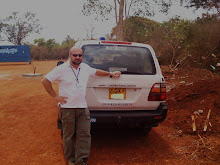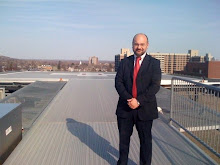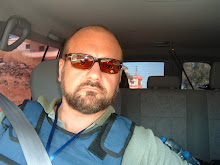 San Pedro is definitely the most important economic centre of Honduras. In San Pedro, dynamic town famous for its brilliant economy, few successful businessmen have reached an incredible powerful economic dimension. Such success has enable them to take part at the political debate as one of the most influential lobby.
San Pedro is definitely the most important economic centre of Honduras. In San Pedro, dynamic town famous for its brilliant economy, few successful businessmen have reached an incredible powerful economic dimension. Such success has enable them to take part at the political debate as one of the most influential lobby.Zelaya, the ousted President, at the beginning of his Presidential career was part of the “club” of industrials and businessmen loyal to the US influence in Central America. He received their blessing and political support. During the first part of his mandate he managed the country stimulating, reinvigorating and improving the existing trade relationship with the US. The US has a specific interest in the country which hosts the largest US military base in Central America (Palmerola). But something happened. A “new” destabilizing element took the upper hand and marked a dramatic shift in the management of the foreign affairs of Honduras. Chavez and his ALBA (left wing inspired organization of Bolivarian States) entangled the Honduran political arena intoxicating first the President Zelaya who dramatically changed his set of political priorities, goals and supporters. This element triggered the famous event that forced Zelaya to leave the country.
The political dynamics behind the scenes are not the main argument of this blog post. Nevertheless it is worth reminding the importance of San Pedro de Sula as main economic site in Honduras, house of lobbyists and ghost decision makers. Which role will be played by San Pedro economic elites before and during next Presidential election remain to be seen.
I visited San Pedro de Sula in April as part of the country Security Risk Assessment, before the political crisis took place. Here some findings regarding the level of criminality, the threats and the instability factors in the San Pedro urban area and in its region.
GENERAL SECURITY SITUATION
Cortes Department (San Pedro surroundings)
General Situation - Crime
The most potentially dangerous sites in terms of presence of criminality are located in the Sulasono Valley. Only few areas can be considered moderately dangerous: Omoa, San Antonio, Santa Cruz Yohoa and San Francisco.
The most frequent criminal acts are kidnappings, express kidnappings (the victim is released in few hours after he/she withdraw money from ATM machine), extortion, assaults and violence connected with narco traffic.
There are areas too dangerous to adventure through in the region, while it is possible/recommendable visit other municipalities only if in company of somebody known in the community or local officials.
Ironically any police escort could dramatically endanger the presence of the visitor.
The risk posed by crime in this area is assessed as high.
Organized Crime – Cortes
The crime rate is very high in this area.
People generally do not report criminal acts for two reasons: fear of retaliations from criminals and lack of trust in the law enforcement systems, both police and justice. Besides corrupted police could inform criminal about a report and trigger retaliation.
The risk posed by crime in this area is assessed as high.
Urban Department of San Pedro Sula
General Situation – Crime
Usually two different kind of criminal aspects are present here: crime due to social frictions and delinquency (ordinary and common).
Both are fueled by the media which emphasize the culture of fear among people. This situation stimulates the lack of confidence in the police as institution and creates a subculture of isolation (one is alone against crime). This phenomenon motivates people not to report incidents and crime related events.
Drug couriers move freely in the urban departments since San Pedro is part of the large drug corridor from Colombia to the Mexican/US border. Part of the drug shipments are used locally to pay salaries to those supporting their logistic operation.
The risk posed by crime in this area is assessed as high.
Organized crime – San Pedro Sula City
Large international organized groups of criminals are operating in town. The leaders are Colombian and Mexican. They are in charge of the transportation across Honduras of large quantity of drug. These groups use local gangs “Maras” to support and defend their activities. Several killers are recruited by drug cartels.
The Maras are used to distract police from other areas where the drug is transported.
Gangs indeed organize skirmishes or crime incidents in order to gather the police out of a different area where narco traficants are managing their operations.
The police and the judiciary system are very corrupted. The impunity reaches very high levels.
Money laundering is a widespread phenomenon as well. The great majority of the victims of homicides are connected with some criminal activities or groups. The price to execute somebody can be as low as $50.
Some peripheral areas of San Pedro represent an attraction for those populations living in other poorer regions. Those villages are the most perilous.
The risk posed by crime in this area is assessed as high.
Threat mitigations measures:
Best time frame to conduct field operation between 6:00 AM and 6:00 PM.
The Soaso area is considered at high crime risk. Nevertheless the escort of police is not recommended since can be clearly identified.
It has been reported that people has been killed in attempt to steel their cellular phone. For this reason the cellular is used only in not visible areas.
Finally, the good and appropriate personal behavioral conduct of the monitor is a further element to consider within the general mitigation measures.
Accidental Shooting:
The risk to be involved in an accidental shooting is low.
Medical Emergency:
In San Pedro are located several good medical facilities. In town are available ambulances, clinics and health centers providing basic services.
The fire fighters have an ambulance too.
The risk of not receiving adequate medical cares is assessed as low.
Fire
The risk of injury from fire is assessed as low.
Road Travel
The conditions of the roads in town are very good. The great majority of the urban roads are paved. The traffic can be chaotic. The risk of being involved in a car incident is assessed as low.
Recommendation:
Drivers should attend a 4x4 wheel drive course. Secondly, the defense/offense driving courses should be offered to drivers as advanced courses after completion of the 4x4.
Picture on top courtesy W
 iki.
iki.Author visiting a school in the surroundings of San Pedro. Field offices were located within School complex, offered by Ministry of Education.





